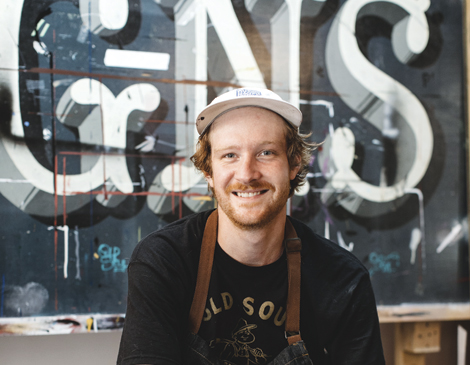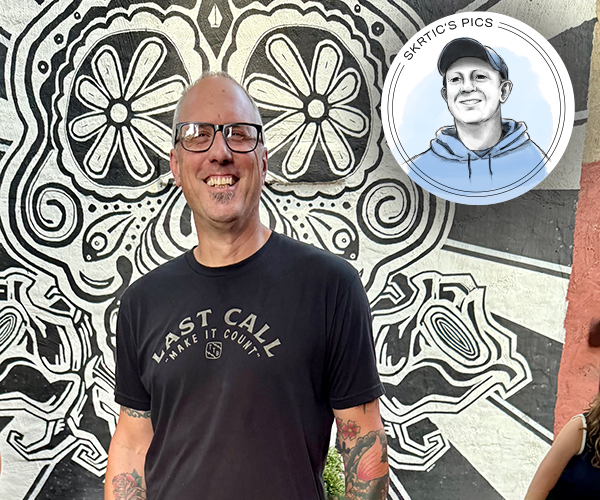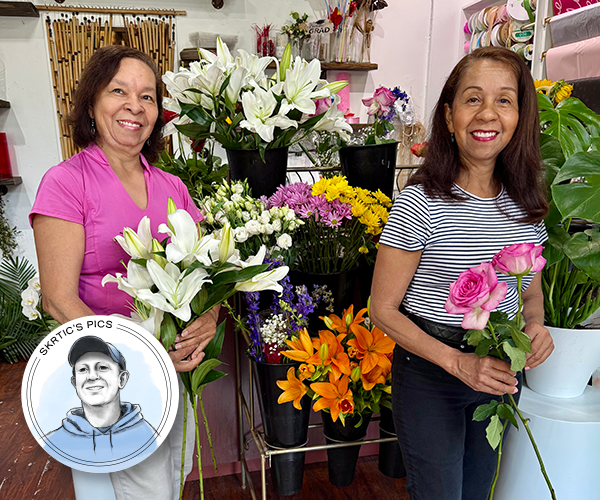When Hingetown’s Larder Delicatessen and Bakery opened in April, its owners wanted to give it an Old World feel, evoking turn-of the-century delis in New York City where meats were slow-cured in house for days, and kids sat sipping thick chocolate phosphates at the counter. For Larder’s refurbished garage-door entrance, the signage had to reflect that same vintage ethos. “It’s the first thing you see when you walk in,” says co-owner Jeremy Umansky.
Enter Alan Giberson, an artist specializing in the retro art of hand-painted advertising. Although only 26, the founder of Old Soul Sign Co. is very much of another era. He favors ’30s jazz, prefers shooting photos with vintage cameras and says walking into an Apple store makes him nervous.
To match Larder’s nostalgic vibes, Giberson modeled the signage after a photo of a 1901 SoHo deli. He spent three days painting gold leaf lettering on the garage door, using paintbrushes that used to belong to his grandfather, an amateur sign painter. In Victorian style, the script curves into rounded, bulbous ends, thickened to make the letters more pronounced. The type, Giberson says, is reminiscent of signs that once hung over Victorian pubs.
“It really helps tie in the romance of what we were trying to capitalize on,” Umansky says.
For Giberson, the process of painting is just as important as the final product. When ’80s retailers began creating signs using computer printers instead of painters, he feels something was lost.
“Handmade signs have a certain human aspect that people just instinctively connect with,” says the Strongsville native. “When you see a slight imperfection, it makes you realize we’re all human here.”
Giberson’s creations start as pencil sketches. To transfer the design onto a wall or window, he uses a projector or a pouncing technique, where tiny holes are punched through the outlines of the letters and marked in charcoal on the surface. He spends days painting the signs, often attracting a small crowd.
“Getting to see how things are made is a rare sight these days,” he says. “Normally this kind of thing is done behind closed doors.”
For Giberson, art is all about engaging the public. At St. Ignatius High School, he dabbled in graffiti art, which got him into lettering. After graduating in 2011, Giberson received a scholarship to study photography.
But after one semester at San Francisco Art Institute, he found he learned more from experience than lectures. He dropped out and spent two years couch-surfing along the Pacific Coast. Giberson returned home in 2013 with a new appreciation for the kindness of strangers.
Broke that Christmas, Giberson decided to create personalized name plaques as gifts. Surfing the web for inspiration, he discovered hand-painted signs were making a comeback. His interest deepened after seeing a documentary on professional sign painters at the Capitol Theatre.
“I saw this as a way to make money, but also have a lot of creativity,” he says.
For a year, Giberson immersed himself in the study of letters. Naturally, he went old-school — poring through vintage sign-painting manuals from local libraries, some so old that he was required to wear white gloves while reading them. In those months, his apartment walls were covered with the angles of alphabets, from the curve of an S in an eccentric French font to the perfect thickness of a V in a Tuscan full-block script.
Giberson’s big break came when he painted the storefront of Lakewood’s Southern comfort eatery Chow Chow Kitchen in 2015, lettering the window, menu and walls in a casual, freestyle “southern twang.”
Giberson is now lettering full time, working for establishments such as Vero Pizza and Noble Beast Brewing Co. In September, he was hired to redo the lettering on a historic Cleveland Terminal Valley Railroad car that the Midwest Railway Preservation Society plans to open to the public this fall.
“I like the historical aspect of [sign-painting],” says Giberson. “It’s cool to think that this sign I’m making may still be up when I’m 80.”




